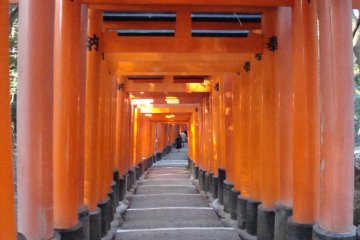
Getting to Know: Fushimi Inari Taisha
AshFushimi Inari Taisha is a beautiful shrine that's particularly photogenic and famous - the grounds are home to thousands of red torii gates which frame its trails.

Fushimi Inari, officially known as Fushimi Inari Taisha, is a beautiful Shinto shrine in southern Kyoto, famous for its thousands of vermilion torii. The torii gates along the way are donations from individuals and companies and on the back of each gate is the name of the donor and the date of the donation.
The trails lead into the wooded forest of the sacred mountain Inari, which is 233 meters high and is part of the shrine grounds. The hike to the top of the mountain and the way back take about 2-3 hours.
The shrine is dedicated to Inari, the Shinto god of rice. Since it is believed that foxes are Inari's messengers, there are numerous fox statues throughout the shrine grounds. The Fushimi Inari Shrine is the main shrine of all 30,000 Inari shrines in Japan.
This is the goal of most visitors to Fushimi Inari Shrine. Located about 45 minutes up the mountain, this intersection features some fabulous views of Kyoto on clear days. Many hikers decide to stop here as there are fewer and fewer torii from this point on.
Foxes are seen as the messengers of Inari, Shinto god of rice; the stones foxes seen around the shrine are even called Inari as well. Many of them have a key in their mouth which depict keys to granaries blessed by Inari.
One minute walk from Inari station (JR Nara Line), or a 4-minute walk from Fushimi-Inari Station (Keihan Main Line) just beyond.

Fushimi Inari Taisha is a beautiful shrine that's particularly photogenic and famous - the grounds are home to thousands of red torii gates which frame its trails.

Fushimi Inari Taisha, an icon of Kyoto, is affectionately known as the temple with a thousand torii gates. As you venture up, you will be greeted with gates painted in orange. I came during the early evening and headed for the summit. The lack of crowds made it very peaceful, yet their very absence seem creepy, like a ghost town. For those brave enough to reach the top, a magnificent view of Kyoto’s city lights awaits.
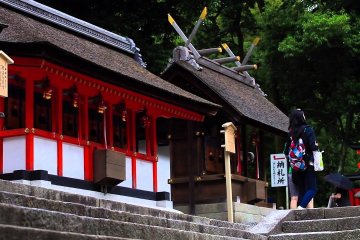
Fushimi Inari Taisha Shrine is located on the side of Mt. Inari is an UNESCO World Heritage site in Japan famed for its many torii gates; it is a “must-do” for anyone visiting Kyoto.

The challenge of climbing the top of Fushimi Inari Taisha, the main Inari shrine of Japan.

Fushimi Inari Shrine is in the south of Kyoto and is famous for its thousands of vermilion torii gates. The trails through the gates and around the shrine lead you into the forest and up Mount Inari.

Fushimi Inari torii gates in Kyoto. You have seen this shrine in guide books, Memoirs of a Geisha and other films, or perhaps you have dreamed about seeing it in person.

Fushimi Inari Shrine is the perfect example of an Inari Shrine. The numerous red Japanese gates create a spectacular experience for the visitors.

Fushimi Inari Shrine, famous for its 10,000 scarlet red torii gates, has a long approach running up a mountain in the south of Kyoto.
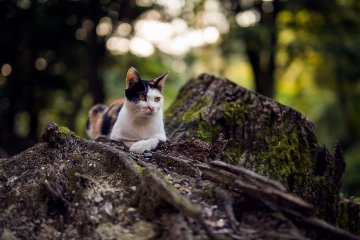
Tourists flock in thousands to Fushimi Inari Taisha each year, vying to get a glimpse of the iconic orange 'torii' gates and meandering paths. Yet this photo story from Saskia Gilmour pays homage to Fushimi Inari's favourite residents - the cats of Fushimi Inari.
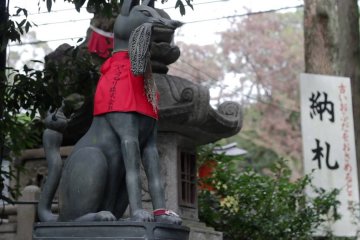
Take a visual journey into Kyoto's most famous Shinto temple which is famous for the thousands of torii gates and the bright colours.

A strong Shinto atmosphere, thousands of torii to go through, and beautiful scenery to enjoy. But prepare yourself for this 4-km course!

Visiting Fushimi Inari Taisha in Kyoto at night can be a bit spooky, but I still climbed all the way to the top and loved it.

At New Year, Fushimi Inari Shrine is always extremely crowded but the atmosphere is festive and exciting. Evening is a good time to visit.

One of Kyoto's most famous shrines is Fushimi Inari Shrine. The endless torii gates create a fairytale atmosphere. While it is a few stops from Kyoto by local train, it is worth the journey, even in the height of summer.

Fushimi Inari is a shrine located in the south east of Kyoto City. It was founded in year 711 and is dedicated to the Inari Kami, god of cereal and especially rice, who are a symbol of prosperity in Japan. In the shrine, he is commonly depicted as a fox. The shrine is popular for its incredible number of traditional Japanese gates that transform its alleys into real tunnels.

Many food stalls spring up around Fushimi Inari at New Year, selling delicious snacks to the crowds of New Year visitors.

At the entrance courtyard to Fushimi Inari, you are greeted with architecture similar to most other Japanese temples, but duck around to the back and you're rewarded with a maze of orange torii gate-lined paths meandering up the slopes. A few hundred steps upward gives you remarkable views of Kyoto and the surrounding suburbs.

Fushimi Inari with its thousands of red torii gates is one of the most famous and picturesque spots in Kyoto. A major shrine in the Inari area.

Hotel Anteroom Kyoto is a stylish hotel with a homely and artistic space, one stop south of Kyoto.
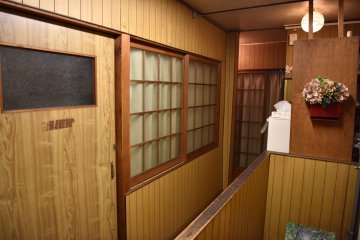
Ladies Inn Guesthouse Usagi-Momiji: by far the best accommodation I have ever found in Kyoto

Discover new friends and receive a warm welcome home on the quiet south side of JR Kyoto

Hotel Anteroom Kyoto has designed breakfast in its own style, for their visitors to refresh and detox themselves. They have carefully selected ingredients and products to gently awake you in the morning, recharging yourself to face a new day of adventure. Many of its signature dishes are made by the hotel's kitchen with seasonal ingredients. They believe that the food in season is the best fit, a reflection of what nature wanted us to eat during that time of the year.

One reason ramen is an icon of Japanese cuisine is that it has a life of its own, its ingredients and way of cooking having a sense of dynamism, transforming its taste from
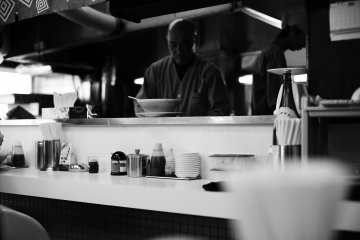
Dai-ichi Asahi Ramen is a well known Kyoto-style ramen shop located near Kyoto station. The store is known for its shoyu (soya) based broth that is thicker than usual. As it is popular, get ready to line up. Prices are affordable and a hearty bowl of the signature ramen is 800 yen. Located off Takakura Dori off of Shiokoji Dori, the store is open from 5 in the morning until 2 a.m. at night.

Tofukuji temple (東福寺), particularly known for its autumn leaves, was founded in 1236 and is the head temple of the Tofukuji School of the Rinzai sect of Zen Buddhism.

Sanjusangendo, officially called Rengeō-in, is a Buddhist temple of the Tendai sect located in the Higashiyama district of Kyoto. The temple’s main hall is famous for housing 1,001 statues of Senju Kannon (1,000-armed Kannon), the goddess of mercy. Taira no Kiyamori built the temple in 1164 as a retirement palace for Emperor Go-Shirakawa. Years later, the structure burned down but was reconstructed in 1266. The name Sanjusangendo translates to “a hall with 33 spaces between columns'' and refers to the number of intervals between the temple’s support columns. The focal point of the temple is its main hall. The impressive one-story building measures 120 meters long, making it the longest wooden structure in Japan. The main hall’s humble architectural style is characterized by its woodwork and slanted roof of wooden shingles. Despite its lack of outward ornateness, the hall’s sheer size commands respect from visitors and exudes a ubiquitous air of sacredness. Apart from the main hall, the grounds are also home to tranquil gardens, temple structures painted in brilliant vermillion, and an annual archery festival called Toshiya Matsuri, where thousands of participants come to test their bow skills and endurance. Witness the 1,001 Senju Kannon Statues Inside the main hall, walk among hundreds of golden, human-sized statues of Senju Kannon. The ornately carved statues stand in elegance with two of their 1,000 arms positioned in prayer and their serene faces deep in meditation. Atop their heads sprout additional smaller heads, which, along with goddess’ 1,000 arms, help her better fight human suffering. In the center of the hall sits a large statue of Kannon, who is positioned similarly in prayer with her multitude of arms fanned out behind her. The 12th and 13th-century statues are carved from Japanese cypress and lacquered with gold leaf, and the large Kannon statue, in particular, is considered a National Treasure. The 1,000 smaller statues are situated on both sides of the seated goddess in ten rows of 50. In front of the first row of Kannon statues, stand 28 additional sculptures of Buddhist guardian deities, many of whom, in contrast to the meditative statues, are poised in protective stances. The visual of hundreds of golden statues against the wooden hall’s muted walls is a truly awe-inspiring sight. Visitors cannot help but be comforted by the overwhelming sight of the serene goddess of mercy. Admission to Sanjusangendo costs 600 JPY for adults, 400 JPY for junior/senior high school students, and 300 JPY for children.
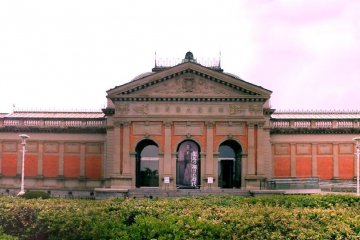
The Kyoto National Museum is one of the major art museums in Japan. Located in Kyoto's Higashiyama ward, the museum focuses on pre-modern Japanese and Asian art. [Wikipedia]